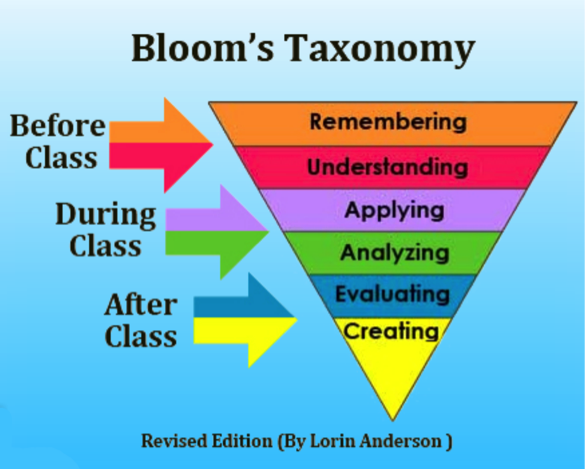OTAN News
What, Why, and How to Implement a Flipped Classroom Model
What Is a Flipped Classroom?
A flipped classroom is a "pedagogical approach in which direct instruction moves from the group learning space to the individual learning space, and the resulting group space is transformed into a dynamic, interactive learning environment." Simply put, students learn the content through online/video instruction, at home. Then, the classroom transforms into a dynamic, interactive learning space about the instruction.
Four Pillars of F-L-I-P™
The acronym is defined as the following:
- F - Flexible Environment
- L - Learning Culture
- I - Intentional Content
- P - Professional Educator
For the full explanation, take a look at this PDF from The Flipped Learning Network: FLIP Learning - What Is Flipped Learning?
Fitting With Revised Bloom's Taxonomy
 Image from Michigan State University
Image from Michigan State University
In flipped learning, the lower level of the taxonomy like remembering and understanding occurs before class. When students come to class, they engage in higher cognitive levels with peers and an instructor. The evaluation and creative levels can be incorporated into the class or assigned for after class. With the flipped classroom model, the major cognitive processing happens for students with their teacher and classmates.
Why Should You Flip Your Classroom?
The concept of flipped classroom first introduced by Jonathan Bergmann and Aaron Sams, authored the book, Flip your classroom: Reach every student in every class every day (2012), they discussed a couple of reasons why teachers should consider flipping (p.20-33). They also discussed 5 "bad reasons for flipping your classroom" (p.21). Some of the funnier reasons include: "Because you think you will become cutting edge," "Because you think flipping your classroom exempts you from being a good teacher," and "Because you think it will make your job easier."
How to Implement a Flipped Classroom?
From John Dunn's guide, "The 6-step guide to flipping your classroom," (2014) presented these "easy" steps:
- Plan a lesson intended for flip and outline key learning outcomes.
- Record: Make a video, screen case of the instructor teaching this lesson. Include all elements that would be featured in a classroom lesson.
- Share: Send the video to students and explain how the elements from this lesson will be fully discussed in class.
- Change: Ensure the classroom space is interactive and extends and does not repeat the recorded lesson.
- Group students with a collaborative task.
- Regroup: Share, ask questions, collaborate, and offer feedback.
Full Article: What, Why, and How to Implement a Flipped Classroom Model
References
- Bergmann, J., & Sams, A. (2012). Flip your classroom: Reach every student in every class every day. Eugene, Or: International Society for Technology in Education.
- Center for Teaching Innovation at Cornell University. (2017). Flipping the classroom. Retrieved from https://teaching.cornell.edu/teaching-resources/online-hybrid-teaching/flipping-classroom.
- Dunn, J. (2014). The 6-step guide to flipping your classroom. Retrieved from https://kitzu.org/flipped-classroom-model/
- Flipped Learning Network (FLN). (2014) The Four Pillars of F-L-I-P™
- Citation: Flipped Learning Network (FLN). (2014) The Four Pillars of F-L-I-P™

